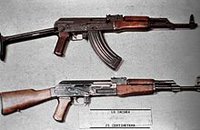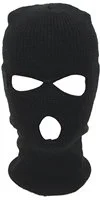
GLOSSARY
AK-47 (also known as Kalashnikov or Kalash) is 7.62×39 mm assault rifle developed in the Soviet Union by Mikhail Kalashnikov. Known for its simplicity, reliability, and utility value, AK 47 is still used by many armies around the globe.
A balaclava is a hat that can be rolled down and used as a mask that covers the whole face, leaving openings only for the eyes and mouth. Balaclavas were first used by the British troops during the Crimean War (1853–56) in order to protect their faces from cold weather. Its name derives from the Crimean city of Balaclava, the site of the 1854 Battle of Balaclava, in which Russian imperial forces clashed with the allied forces of the British, the French, and the Ottoman empires. In the twentieth century, balaclavas became associated with activities that require anonymity: they have been used by terrorists and criminals, but also by protesters and political activists who feared government persecution. Russian activist group and music band Pussy Riot used colorful balaclavas in their controversial 2012 anti-Putin performance, leading to the imprisonment of two group members. Balaclavas were also widely used in the Maidan protests of 2013–14, due to the protection they offered against the cold and the police authorities.
BM-21 “Grad” is a truck-mounted 122 mm multiple rocket launcher, developed in the early 1960s in the Soviet Union as a replacement for Katyusha multiple rocket launcher, which was one of the most successful mass-produced Soviet weapons of World War II. Although the Grad system is not as precise as conventional artillery, it can fire forty rockets in twenty seconds, affecting a large area. Grad also has the advantage of being mobile—it requires only ten minutes for reloading and only two minutes for getting it ready to move to a different location. Grad’s mobility allows the separatists to use it for hit-and-run operations on fortifications and security checkpoints, as well as for targeting civilian property and terrorizing the population. Grads are used by both sides in the conflict: the Russian-backed insurgents and the Anti-Terrorist Operation forces. The Grad attacks against civilians have been a matter of controversy since neither side is willing to claim responsibility for civilian casualties. Many of the Ukrainian military experts and commentators have argued that the insurgents systematically use Grads against the civilian population in order to substantiate their claims that the Ukrainian government is conducting deliberate and systematic “cleansing” of Russian-speaking population in the Donetsk and Luhansk regions. The nickname Grad (Град) means hail in Ukrainian and in Russian; most of the poets in the anthology use hail in this double sense, referring both to the rocket launcher that hits indiscriminately and affects a large area, and to the meteorological event from which it gets its nickname.
A mortar is a short-distance ballistic weapon designed to land bombs on nearby areas. Mortars are normally used to target areas with a heavy concentration of enemy troops. The use of mortars in an urban setting often results in “collateral damage,” that is, destruction of private property and in civilian casualties. Due to its portability and indiscriminateness, mortars are often used for terrorizing and intimidating the civilian population.
OUN is a volunteer battalion that takes its name from the Organization of Ukrainian Nationalists (OUN), founded in the 1920s and characterized by nationalism with proto- fascist leanings, rendering its controversial history a matter of scholarly debate. The OUN battalion is commanded by Nikolai Kokhanivsky. In July 2014, Borys Humenyuk had been elected second in command. Humenyuk’s are the only poems appearing in the anthology written by an acting soldier.
Ruskis is the familiar derogatory term the translator had used to stand for vatniks, also vata (Russian vatniki [ватники], a type of cotton-padded winter coat widely worn by soldiers in World War II, the GULAG inmates, and by an impoverished segment of the Soviet population). Vatnik originally appeared in Russian internet (or runet) as a visual—a meme. The word vatnik is used to refer to an uncritical consumer of state propaganda, who identifies as a Russian patriot. In popular meme representations, vatniks embody the common stereotypes about Russians, such as their tendency to alcoholism, aggressive and militant forms of patriotism, unreflective hatred of everything non-Russian, an inchoate commitment to “spirituality” and “morality,” and lack of irony. The term vatnik alludes to its bearer’s subordinate mentality since the coats were commonly worn by lower-ranked soldiers and prisoners, and had low-cut collars, causing the wearer to stoop in order to keep the back of his neck warm and therefore to adopt a servile-looking posture. The identification of pro-Russian anti-government insurgents in Eastern Ukraine as vatniks widened the meaning of the term to include such characteristics as excessive aggressiveness, military adventurism, and an imperialist commitment to the reunification of the former Soviet Republics under the auspices of the Russian Federation.
Ukes is a mildly derogatory Ukrainian diaspora term that one of the translators chose to render a Russian derogatory term ukropy (укропы), a word for “dill,” a potentially invasive garden herb common in the Ukrainian cooking. When applied to a person, the term acquires multiple negative connotations: of something plant-like, spineless, and difficult to get rid of. Initially, the term was used by separatist insurgents and Putin-sympathizers to refer to the Ukrainian army soldiers and volunteer units. However, it quickly came to stand for Ukrainians in general, and more generally, for those affected by “Euro-propaganda.”
Zinc coffins were used in the Soviet Union to transport bodies of fallen soldiers back to their homes. During the Soviet invasion of Afghanistan (also known as Soviet-Afghan war of 1979–89), the Soviet soldiers that fell in action were classified as Cargo 200 (Russian: "Груз 200"), and shipped back in coffins made of zinc (also referenced in Svetlana Alexievich’s book Zinky Boys). The armies of the former Soviet Republics still use Soviet codes for classifying casualties: Cargo 200 stands for “irrecoverable losses” (i.e., soldiers killed in action), while Cargo 300 is a code for the wounded soldiers.



